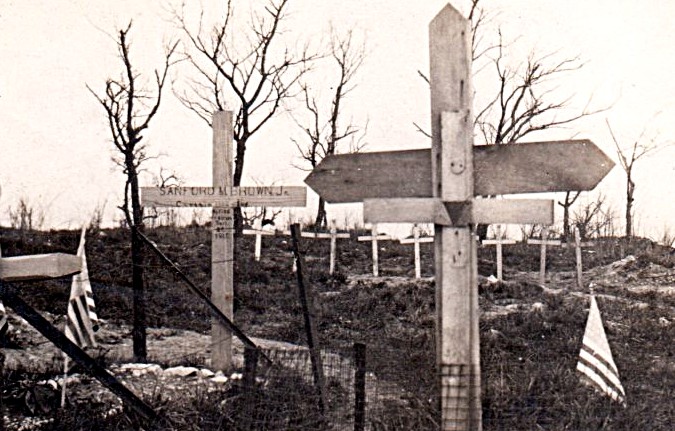Editor’s note: This piece is a bonus piece in a five-part series leading up to the celebration of the 100th anniversary of the Baptist Faith and Message at the 2025 SBC Annual Meeting in Dallas.
“His going cast the shadow over my life which will never be lifted ...” – Sanford M. Brown Sr.

Capt. Sanford M. Brown Jr. was a member of the 139th Infantry, 35th Division primarily composed of men from Missouri. (Photo from Ancestry.com)
Sanford Miller Brown Jr. was a Baptist preacher’s son from Kansas City and a recent graduate of Missouri State University. He was beginning a career in business. Undoubtedly like other PKs of their day, as a boy he and his brother walked to church each week wearing their best knickers. They attended Sunday School and worship and, in all likelihood, sat on the pew on either side of their mother. His father wrote, “Our children became Christians, we believe, in early life, and have been to us a supreme pleasure so far as devotion to their parents.”
In high school, Sanford was a member of the Webster Club. He played the role of a Dutch businessman in the annual senior Christmas play, a comedy titled “An American Citizen.” Active in the Glee Club, he sang first tenor and was the club president in his senior year. That year the Glee Club toured the state, giving concerts at which, the high school annual reported, “every high school and concert hall was filled to capacity.”
Several years after graduating from college, the call for volunteers to fight in what was being called “the war to end all wars” was made. Sanford and his brother Joseph answered the call, both earning officer’s commissions and the rank of captain, sailing for France in the spring of 1918. Sanford was a member of the 139th Infantry, 35th Division, which was primarily composed of men from Missouri.
The sieges of Atlanta and Petersburg during the Civil War were a dress rehearsal for the trench warfare on the battlefields of France and Belgium in World War I. Opposing trenches stretched for nearly 500 miles, separated by “no-man’s land.” Mustard gas, disease, rats, cold, water, mud and “trench foot” were the enemy, too.
Machine guns capable of firing 600 rounds per minute were arranged in patterns of interlocking fire and utilized on a mass scale for the first time. When the order was given to “go over the top,” men rushed out of their trenches across no-man’s land into enemy fire in a grown-up version of “Red Rover, Red Rover.” Unlike the schoolyard game, many never returned. Victories were often measured by yards or even feet gained.
The division went into battle near Charpentry, France, in the Argonne Forest on Sept. 26, 1918. Following a week on the line, they withdrew; the division had suffered a 65 percent casualty rate. Capt. Sanford Miller Brown Jr. was killed on the first day of battle.
His citation read, “For gallantry in action during the six days’ battle from September 26th to October 1st, 1918, Captain Brown fearlessly exposed himself to intense artillery and machine gun fire in order to assist his commanding officer by assuring the proper execution of orders. He was killed while assisting in forming his regiment for the attack on Charpentry.” (Cited: The Story of 139th Infantry)
Years later, his father, writing his autobiography, tenderly reminisced; “Dear Sanford was assigned to the 35th Division. … I have been told that he commanded his regiment in the Argonne battle. In this battle, the dear boy was instantly killed. His body was buried, by a University friend, in the National Cemetery in France, and we let him rest there. His going cast the shadow over my life which will never be lifted, I may say the one great shadow that has fallen on me. Fifteen years have rolled over me since the sad event on September 26, 1918, and the grief for me is just as poignant as the day the cablegram came to me telling me the sad story.”

But his death was not the end of the story, because it had “cast one great shadow” over his father. Sanford M. Brown Sr. was the co-owner and editor of the Missouri Baptist newspaper, The Word and Way. In 1924, at the SBC Annual Meeting, he was one of seven members appointed to a committee to prepare a “new Baptist faith and message.” It was a revision of the New Hampshire Confession of Faith.
It also contained additional statements, including one titled “Peace and War.” That statement begins: It is the duty of Christians to seek peace with all men on principles of righteousness. In accordance with the spirit and teachings of Christ they should do all in their power to put an end to war. The true remedy for the war spirit is the pure gospel of our Lord.
The Baptist World Alliance had adopted a similar statement in 1923. Its inclusion in the new Baptist Faith and Message was undoubtedly, in part, a loving tribute from a grieving father living under “one great shadow.” In the centennial year of the adoption of the Baptist Faith and Message, it is appropriate to remember the overlooked legacy of a fallen soldier on its message, Capt. Sanford Miller Brown Jr. (1893–1918).
— Charles Jones is a retired pastor and Baptist historian who lives in Athens, Ga.
